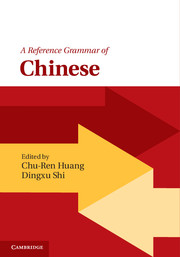Book contents
- Frontmatter
- Dedication
- Contents
- List of figures
- List of tables
- List of contributors
- Preface
- Acknowledgements
- English–Chinese term list
- Chinese–English term list
- 1 Preliminaries
- 2 Syntactic overview
- 3 Lexical word formation
- 4 Verbs and verb phrases
- 5 Aspectual system
- 6 Negation
- 7 Classifiers
- 8 Nouns and nominal phrases
- 9 Relative constructions
- 10 Adjectives and adjective phrases
- 11 Comparison
- 12 Adverbs
- 13 Prepositions and preposition phrases
- 14 Sentence types
- 15 Major non-canonical clause types: ba and bei
- 16 Deixis and anaphora
- 17 Information structure
- Appendix: Punctuation
- Bibliography
- Index
5 - Aspectual system
Published online by Cambridge University Press: 05 March 2016
- Frontmatter
- Dedication
- Contents
- List of figures
- List of tables
- List of contributors
- Preface
- Acknowledgements
- English–Chinese term list
- Chinese–English term list
- 1 Preliminaries
- 2 Syntactic overview
- 3 Lexical word formation
- 4 Verbs and verb phrases
- 5 Aspectual system
- 6 Negation
- 7 Classifiers
- 8 Nouns and nominal phrases
- 9 Relative constructions
- 10 Adjectives and adjective phrases
- 11 Comparison
- 12 Adverbs
- 13 Prepositions and preposition phrases
- 14 Sentence types
- 15 Major non-canonical clause types: ba and bei
- 16 Deixis and anaphora
- 17 Information structure
- Appendix: Punctuation
- Bibliography
- Index
Summary
Chinese has an aspectual system signaled by the presence of aspect markers, contrasting perfective and imperfective aspects. This chapter gives an overview of aspect markers in Chinese.
Definition of aspect
Aspect is a syntactic system where some intrinsic parts of clause meanings are associated with the internal temporal constituency of a situation. The aspect of a predicate refers to how the situation denoted by the predicate is being viewed, such as whether all or part of the situation is viewed. The term “situation” (also known as “Aktionsart” in the literature) refers to states and events (such as activities, accomplishments, and achievements) expressed by predicates according to their temporal properties (see Chapter 4). When we speak of a situation, we usually view it as a process consisting of a series of stages and phases, including the beginning, the continuation, and the completion. Each of these stages is an aspect that can be viewed.
Aspect is traditionally classified as either “perfective” or “imperfective.” When the perfective aspect is used, a situation is viewed in its entirety without explicit reference to any internal individual stages that make up the situation, namely, a complete situation with a beginning, middle, and end all included. Note that the notion of “completion” does not necessarily imply that the situation is “completed.” The perfective aspect focuses on all stages of the situation as a single whole, not just the end of the situation. Highlighting the end of a situation is just one of the possible meanings of the perfective aspect.
When the imperfective aspect is used, part of a situation is viewed with explicit reference to the internal temporal constituency of the situation. The situation described in a clause is not presented in its totality but instead is viewed from within, with a focus on the internal temporal structure or on some subinterval of time within the situation. Hence, the imperfective aspect is incompatible with situations that lack internal temporal structure.
Aspect can be represented by aspect markers. Two main kinds of aspect markers are distinguished to express perfectivity and imperfectivity, respectively, namely, the perfective markers 了 le0 and 过 guo4 on the one hand, and the progressive marker 在 zai4 and the continuous marker 着 zhe0 on the other hand.
- Type
- Chapter
- Information
- A Reference Grammar of Chinese , pp. 116 - 142Publisher: Cambridge University PressPrint publication year: 2016
- 4
- Cited by

